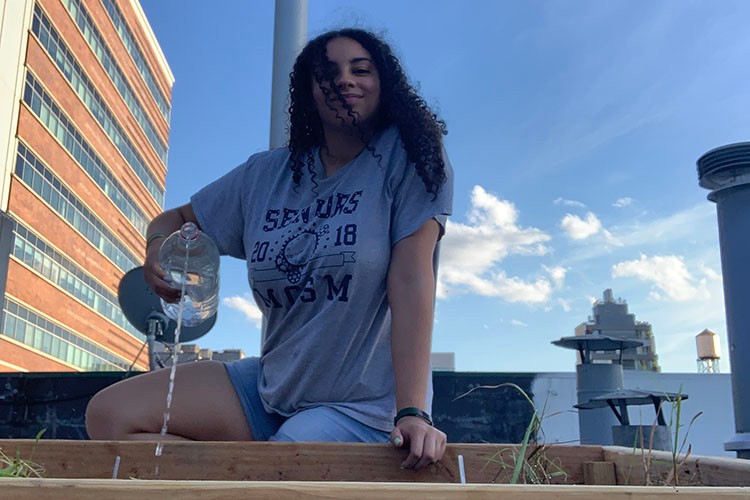Research and Resilience: Undeterred by COVID-19, Hannah Darensbourg ’22 Gets it Done

Environmental Sciences major Hannah Darensbourg ’22 CLAS wasn’t about to let COVID-19 stand in the way of her summer research. And the work she’s managed to accomplish in challenging circumstances may shed new light on climate change, global warming and issues of equity.
Awarded a summer 2020 Villanova Undergraduate Research Fellowship, Hannah was slated to work in Villanova’s research garden, the Villanova Consortium for Agricultural Research and Education. Instead, she found herself fabricating and installing beds of her own on the rooftop of her brownstone apartment building in Harlem, New York.
As part of her experiment, “Ideal Plant Type and Watering Conditions for a Green Roof Garden,”
Hannah is testing the viability of an artificial green roof substrate for three types of native plants and examining their growth response under a series of water conditions. In addition, she is testing how the green roof itself moderates temperature.
The initial challenge was that Hannah’s rooftop is accessible by only a narrow ladder, making it extremely difficult to transport garden boxes. Hannah made three trips to Home Depot in Yonkers, New York—the closest outlet open during the major outbreak of COVID-19 in New York City this past spring—and purchased wood which she painstaking hauled up the ladder onto the rooftop, where she began building her garden boxes.
As New Yorkers sheltered in place and the entire world learned of the tremendous hardships the city was facing, Hannah got down to business. “I had never really built anything before, but due to COVID-19 they couldn’t cut the wood for me at Home Depot, so I figured out an alternative plan,” she says.
“Hannah has the mind of an engineer,” says Hannah’s faculty mentor, Steven Goldsmith, PhD, associate professor of Geography and the Environment. “She truly thinks through issues with project design and monitoring.”
What’s especially important about Hannah’s work is there has not been a great deal of rooftop experiments conducted in the Northeast US, so fresh research isn’t readily available. She built four garden beds and planted them with two different kinds of plants, varying the watering frequency to determine their ability to survive rooftop conditions such as direct sun and lack of water. Hannah plans to continue with her passion for urban ecology research and will present her findings at the VURF poster session next spring.
“During our weekly online meetings, I was amazed by Hannah’s level of preparation,” Dr. Goldsmith says. “She’d already thought through the questions I was going to ask. Personally, I feel Hannah's project epitomizes the ingenuity and perseverance of our undergraduate students.”
